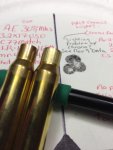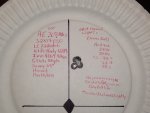Neck sized my first Lapua 308 virgin brass last night.
Used Redding neck die with carbide expander ball.
Very lightly lubed necks (graphite inside, rcbs outside) and experienced galling that fouled the die and the expander ball.
I usually use LC Match brass and have a pretty established technique.
I have never experienced this problem before.
I buffed off the expander ball and cleaned the inside of the die (dowel with JB'ed patch) then went heavier with the lube.
Pictured is the scored brass with the heavier lubed case next to it.
I know now that the Lapua brass is persnickety when compared to virgin LC 77 brass (I have a good supply of old-new stock).
I am disappointed by this brass so far; all the press about it gave me high expectations.
So....Is this unusual? Is the Lapua brass worth it?

Used Redding neck die with carbide expander ball.
Very lightly lubed necks (graphite inside, rcbs outside) and experienced galling that fouled the die and the expander ball.
I usually use LC Match brass and have a pretty established technique.
I have never experienced this problem before.
I buffed off the expander ball and cleaned the inside of the die (dowel with JB'ed patch) then went heavier with the lube.
Pictured is the scored brass with the heavier lubed case next to it.
I know now that the Lapua brass is persnickety when compared to virgin LC 77 brass (I have a good supply of old-new stock).
I am disappointed by this brass so far; all the press about it gave me high expectations.
So....Is this unusual? Is the Lapua brass worth it?



